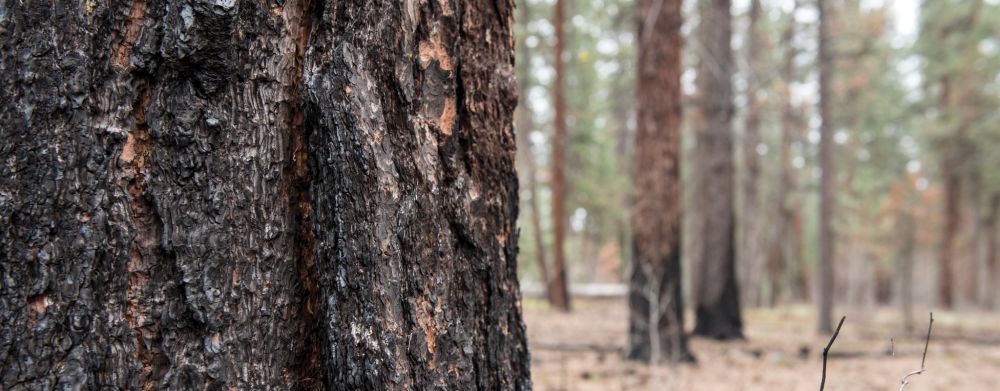
As fast-moving fires tore through Oregon’s forests and communities, causing widespread and destructive impacts, Oregon State University College of Forestry researchers quickly organized to support the state’s response. Faculty and staff worked with partners to produce proposals and share research to help inform future policy decisions and support a systems-based, collaborative approach to recovery.
“The impact to human lives and livelihoods has been tragic,” says Tom DeLuca, Oregon State University’s Cheryl Ramberg-Ford and Allyn C. Ford Dean of the College of Forestry. “As we plan recovery, it is clear that it is inadequate just to say ‘we will rebuild.’”
Instead, DeLuca continues, the post-fire recovery will best be met by a systems-based approach that integrates water resources, fire-adapted infrastructure, communities and landscapes, and education and adaptation all within the context of a changing climate.
“This approach,” DeLuca explains, “aims to improve the resilience of forests and communities well into the future.”
Though fire has always been a part of our western landscapes, more than a century of widespread fire suppression and land use changes in Oregon have altered fuels, vegetation, and historical fire regimes. The intersection of climate change, drought, extreme weather, natural fire regimes and the ever-expanding human footprint has created a complicated fire equation. Fire seasons are longer, drier and hotter due to climate impacts and increase our risk of destructive wildfire while disproportionately increasing the burden on vulnerable populations. While it’s understandable to want a simple solution to fire concerns, the fire equation is too complicated for one-size-fits-all answers. From ignition to suppression to geography, the variables are constantly shifting.
“Fire is truly a global change issue and there is no single fix that we can invest in for success,” says Meg Krawchuk, associate professor of fire and landscape ecology. “These solution portfolios need to be tailored to particular landscapes and geographies and include the important social and ecosystem dimensions relevant to each place.”
The College of Forestry is world-renowned for its fire-related research, including fire history and ecology, fuels treatment (thinning and prescribed fire), risk analyses, and social dimensions, like work in governance, social justice and equity, and public health. OSU’s world-class Forestry and Natural Resources Extension Fire Program is the critical link that distributes information beyond campus, helping communities become more fire-adapted.
Some of the ways the College of Forestry’s fire research work aides Oregonians includes:
• Advising state and federal leaders on appropriate fire policy, including expanding strategic use of commercial thinning, prescribed fires, and managed wildfire as forest management tools.
• Researching impacts on soil and water quality.
• Assisting in post-fire planting and planning, including addressing and discussing questions around seed availability and appropriate seed zones, assisted migration and climate mitigation and availability of seedlings.
• Working collaboratively with agencies and partners to conduct research on prescribed burning versus suppression approaches and initiate activities to improve forest health and keep communities safe.
• Integrating Traditional Ecological Knowledge and Indigenous burning practices with emerging research and fire science.
• Launching the Forestry and Natural Resources Extension Fire Program in early 2020. The program assists in identifying Oregon landscapes in the highest need of a strategic focus of resources to reduce wildfire and landscape health risks at a statewide scale. It also assists with implementing projects on the ground in priority landscapes and provides education and outreach.
• Assuming a leadership role while working across disciplines with other OSU colleges, including the College of Agricultural Sciences and College of Engineering to support wildfire response and recovery.
The research and expertise within the College of Forestry can contribute to recovery and adaptation, but will not be sufficient on its own. The effort requires integrating emerging research with contributions from the impacted communities who have on-the-ground, experience-based knowledge, professional skills, and insights to apply to the task.
“The forest, the interface and your house are all connected fuel. The future work will include all landowners: homeowners, neighborhood associations, communities, small woodland owners or families, forest industry, Tribes, states and federal partners – all doing their part within their mission to sustain their land,” says John Bailey, professor of silviculture, forest and fire health.
The college is committed to producing science and research that helps guide the way towards a more fire-adapted future.
“Beyond integrating the strategic use of fire and fuels management into a vision for a sustainable future informed by Traditional Ecological Knowledge, we must focus attention and investment on human development patterns and fire adapted housing and communities,” DeLuca says. “We must also pay special attention to issues of social justice, equity and public health. Working together to address these issues will not be easy, but the costs of inaction are too high.”
This story was part of the College of Forestry’s 2019-2020 Biennial Report.

